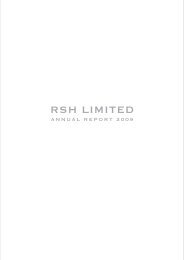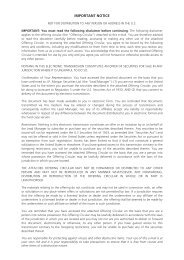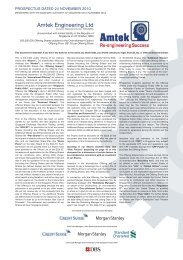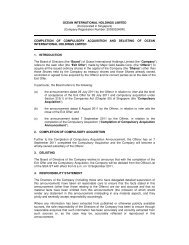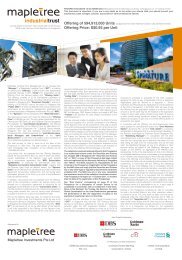O TTO M ARINE L IMITED - Microsoft Internet Explorer - SGX
O TTO M ARINE L IMITED - Microsoft Internet Explorer - SGX
O TTO M ARINE L IMITED - Microsoft Internet Explorer - SGX
Create successful ePaper yourself
Turn your PDF publications into a flip-book with our unique Google optimized e-Paper software.
uilding such vessels. Higher demand for vessels with higher specifications from our customers may increase<br />
our profit margins, while lower demand for such vessels from our customers generally results in lower profit<br />
margins.<br />
Other factors that significantly affect the demand for vessels in the offshore marine industry include the<br />
following:<br />
the age and condition of the existing global fleet of offshore support vessels and the actual and planned<br />
replacement of such vessels;<br />
the cost of building new vessels compared to the cost of purchasing and/or repairing existing vessels<br />
and/or the charter rates of vessels available for charter; and<br />
changes in laws and regulations that affect the technical specifications required of offshore support<br />
vessels.<br />
The Supply of Vessels in the Offshore Marine Industry<br />
Our results of operations are also affected by the supply of vessels in the market. An increase in the<br />
supply of vessels could result in our customers placing fewer orders for vessels with us or paying lower prices<br />
for vessels that they do order, either of which would have an adverse effect on our revenues. The number of<br />
vessels ordered is usually based on the estimated demand for such vessels in the future. As there is a lag<br />
between the time new vessels are ordered and the time of their actual delivery, there could be a mismatch in<br />
demand and supply when fleet owners take delivery of the vessels.<br />
The entry into the market of new vessels or vessels on charter would increase market supply. During<br />
periods of low demand, such an increase in supply would intensify competition and may curtail the<br />
strengthening of or reduce the selling prices of new vessels and the charter rates of vessels. Customers may<br />
reduce their capital expenditures for newbuildings or default on their existing orders with us or may<br />
renegotiate or terminate their existing charter party contracts with us if they are able to secure lower rates<br />
elsewhere. We would expect any of these events to have an adverse effect on our businesses and results of<br />
operations.<br />
On the other hand, when there is a shortage of vessels in the market, the demand, selling prices and<br />
charter rates for vessels may increase which would, in turn, be expected to have a positive impact on our<br />
revenue and profitability.<br />
Our Production Capacity<br />
Our results of operations and financial condition are affected by the extent to which we successfully<br />
manage our actual and planned production capacity to match with the actual and anticipated demand<br />
conditions for offshore support vessels and the types and sizes of such vessels. If we do not have sufficient<br />
production capacity to meet market demand, we may lose out on shipbuilding contracts that may instead be<br />
awarded to our competitors, which would cause us to forego potential revenues and impede the growth of our<br />
business. Increasing our capacity would increase our costs, but in periods of high demand, we would expect<br />
this cost increase to be more than offset by increased revenues. Conversely, excess capacity during periods of<br />
reduced demand would leave us with high fixed costs but lower revenues, thereby reducing our profitability<br />
and margins.<br />
Our production capacity is dependent on several factors that include: (i) the size of our shipyard in<br />
Batam, Indonesia, (ii) the number, size and capacities of our Syncrolift», slipways, berths and docks, (iii) our<br />
plant and equipment, and (iv) the extent to which we are able to outsource our shipbuilding operations to<br />
suitable third-party shipyards. Our Syncrolift» has the capacity to construct vessels of up to 100 metres length<br />
overall (LOA) and 20 metres in breadth with 3,500 tonnes displacement. Our existing drydock has the capacity<br />
to construct vessels of up to 140 metres LOA � 35 metres in breadth.<br />
We intend to undertake the following upgrading works to our Batam shipyard facilities to increase our<br />
production capacity: (i) expand the usable waterfront of our Batam shipyard from 450 metres to 800 metres,<br />
(ii) extend our Syncrolift» berthside by 32 metres � 245 metres, and (iii) purchase additional gantry cranes.<br />
We have commenced construction of one slipway. We intend to complete these expansion and installation<br />
works by end of the FY2009, which would significantly increase our production capacity.<br />
As at 8 August 2008, we were building 26 vessels in our outsourced shipyards in China with a total<br />
outsourced contract value of S$207.2 million, of which 18 vessels with an outsourced contract value of<br />
43



